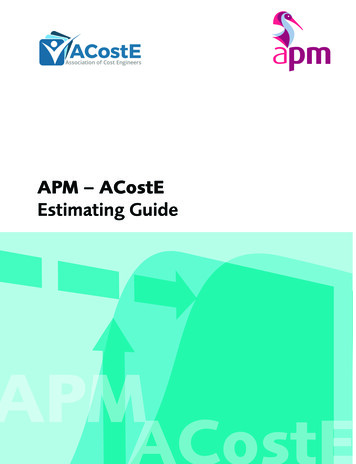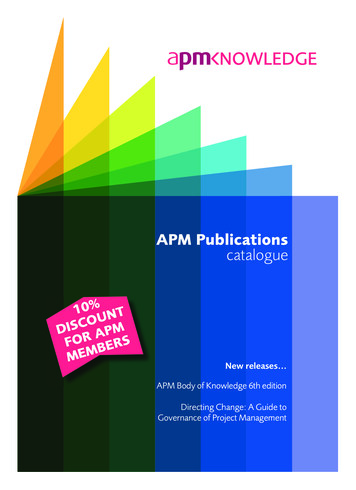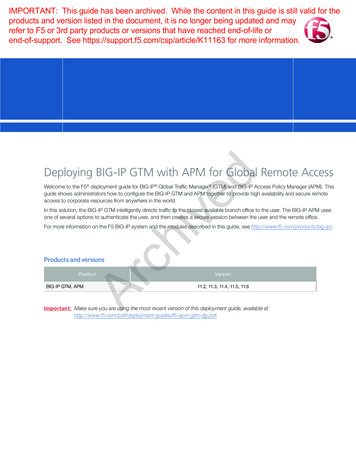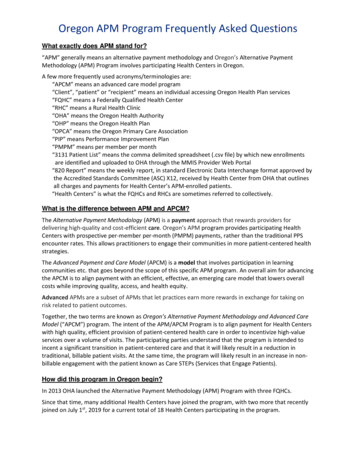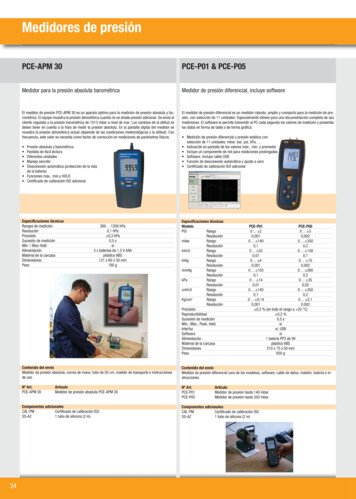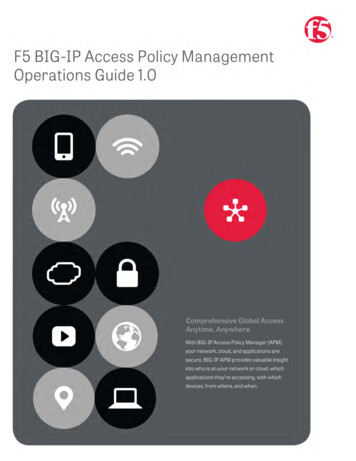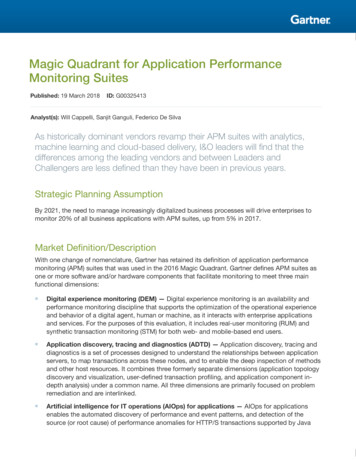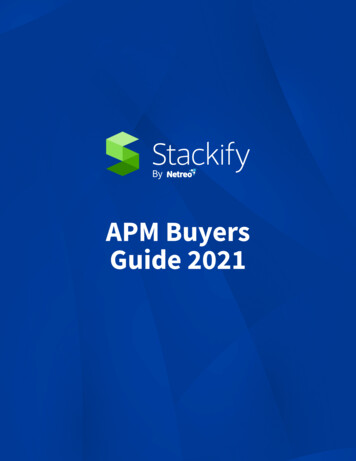
Transcription
APM BuyersGuide 2021Confidential. Copyright 2021 Netreo. All Rights Reserved.
2Table of ContentsExecutive Summary4What is APM: Overview53 Types of APM monitoring toolsUnderstanding the “why” as fast as possibleWhy transactions are slow or failing5566Why Do You Need APM?Better end-user experience6Greater customer satisfaction/meet SLA requirements7Higher developer productivity7Decreased reliance on costly tools8Faster innovation9Collaboration between Ops and Dev9Business Continuity/Reduced Downtime10ROI10118 Essential APM Features1. Performance & MonitoringPerformance of every web request and transactionUsage and performance of all application dependencies1111112. Code-level performance profilingDetailed traces of individual web requests or transactions12123. App and server monitoring and metrics12Confidential. Copyright 2021 Netreo. All Rights Reserved.
3Table of Contents4. Log ManagementBonus Feature: Structured Logging13135. Error MonitoringBonus Feature: View Logs & Errors in code profiling traces14146. MetricsApplication framework metricsCustom applications metrics created by the dev team or business14141415Bonus Feature: App Scoring7. Deployment tracking158. Real User Monitoring16Top APM Tools & Solutions16Retrace16APM is Affordable For All Dev Teams17Advice on Choosing an APM Tool by Role17Developers/architects17Operations17About Stackify by Netreo18Confidential. Copyright 2021 Netreo. All Rights Reserved.
4Executive SummaryModern businesses are dependent on software applications. Ensuring that all of your organization’smission-critical applications are running optimally at all times is a top priority. The right applicationperformance management (APM) tool will monitor your applications proactively and reactively so youcan sleep better at night.Retrace offers a developer-friendly cloud-based solution that fully integrates APM with error tracking,logging, and detailed traces of what your code is doing. Retrace allows dev teams to easily monitor,detect and resolve application issues before they affect the business to ensure a better end-userexperience. The end goal with APM is to help developers understand every millisecond spent in theircode.Observations of the current software development market indicate that highly successful developmentteams are shifting left in order to reduce costs and time spent fixing issues in production. APMs likeRetrace are vital to these teams for that purpose. A Retrace user testifies that “Stackify by Netreo hashelped us improve the quality of our application in many ways. We are a lot more efficient, to a pointwhere we are being proactive with issues rather than hearing about them from customers/customersupport.”There is a wide range of application performance management and application monitoring toolson the market available for developers, DevOps teams, and traditional IT operations. Historically,APM tools have been used by and designed for IT operations. They have been great at monitoringapplications and alerting someone about performance degradation and a select few were able topinpoint the root cause of problems.Newer APM tools, like Retrace, are designed to be used from development and QA to production inorder to identify and fix performance issues and bugs earlier in the life cycle.Since there is a lot of gray area as to what APM is and who it benefits within an organization, it can bedifficult to compare features, costs, and how each tool could potentially work with your technologystack.The primary purpose of this ebook is to provide readers with a framework to evaluate the potentialbenefits and costs of an APM solution. To better understand the benefits and necessary features, we’veaggregated several internal and external sources in this ebook so you can make an informed decision.We’ll start by defining what APM is and the different types, share the primary benefits of using APM, listthe top APM tools along with their features, and close with sharing tips for selecting a tool.Confidential. Copyright 2021 Netreo. All Rights Reserved.
5What is APM: OverviewThe term APM is largely an industry or vendor-created term for anything that has to do with managingor monitoring the performance of your code, application dependencies, transaction times, and overalluser experiences.According to Tech Target, “Application performance monitoring (APM) is the collection of tools andprocesses designed to help information technology (IT) professionals ensure that the applicationsusers work with meet performance standards and provide a valuable user experience (UX).”Since APM is a ubiquitous term for anything and everything performance-elated, somevendors use the term to mean totally different things. APM can span several differenttypes of vendor solutions.3 Types of APM monitoring tools App Metrics-based – Several tools use various server and app metrics and call it APM. At bestthey can tell you how many requests your app gets, and potentially which URLs might be slow.Since they don’t do code-level profiling, they can’t tell you why. Code-level performance – Code profiling and transaction tracing tools such as Retrace are usedto help developers and DevOps teams with code-level performance. Network-based – NPM tools measure application performance based on network traffic eithervia synthetic transactions or real user monitoring.Some other tools do monitoring based on server and application metrics, not code-levelperformance, and sometimes refer to their products as application performance monitoring solutions.Knowing your server CPU or average response of your web server is important and helpful, but APMaims to go way deeper.By leveraging code profiling and other data collection techniques, application performance monitoringtools can provide detailed transaction tracing.Understanding the “why” as fast as possibleIf you want to measure the performance of a web application, it is pretty trivial to parse the access logsand get an idea of how long web requests take. This would give you an idea about overall performanceand which pages are slow. Unfortunately, it doesn’t answer the key question of why.Confidential. Copyright 2021 Netreo. All Rights Reserved.
6Why transactions are slow or failingFor example, a development or operations team can instantly tell from this visual that their database iscausing some performance spikes. They can also leverage their APM to identify exactly which databasequery and web requests were affected.Screenshot from RetraceAPM solutions can help identify common application problems quickly:1. Track overall application usage to understand spikes in traffic2. Find slowness or connection problems with application dependencies including SQL, queues,caching, etc3. Identify slow SQL queries4. Find highest volume and slowest web pages or transactionsWhy Do You Need APM?There are several ways APM tools provide a high return on investment (ROI). They can help withdeveloper productivity, prevent application problems, reduce hosting costs, optimize performanceand prevent costly downtime.Most importantly, APM tools can help you sleep at night.Here are some more reasons.Better end-user experienceUsers love fast software. It creates an overall higher sentiment for your product. It may be hard toquantify, but it helps with customer conversions and retention.Slow performance can impact your bottom line. Amazon found every 100ms of latency cost them 1% insales. We can all relate to trying to buy something online and stopping because it was taking too long.Confidential. Copyright 2021 Netreo. All Rights Reserved.
7It could be that the kids are screaming, it’s time to go to dinner, or some other reason. We sometimestell ourselves we will look at it later when we have more time. Many times we don’t remember, orspend our money on something else. “I almost bought one of those” is the last thing any retailer wantsto hear.One of our clients provides small loans to their customers online. Their website was taking 10-15seconds to load and couldn’t figure out why. They were able to use Retrace to identify that caching wasnot working properly. After applying the fix, they were immediately able to see a substantial increase inbusiness.Greater customer satisfaction/meet SLA requirementsMany B2B companies have service-level agreements (SLAs) with their partners. These agreementstypically have clear penalties written into them if their software is not online and working properly.A short outage by Amazon AWS reportedly cost them 2% of their total revenues due to SLA credits. Thefive-hour outage likely cost them millions in revenue and caused problems for many clients, includingApple, Adobe and Netflix.Amazon reportedly had to refund 10-30% in service credits. Many vendors offer service credits basedon how bad the SLA was missed. Here is an example of a table that defines how a breach in SLA ishandled.Percentage Uptime98% or greater but 99.7%97% or greater but 98%96% or greater but 97%94% or greater but 96%90% or greater but 94%Less than 90%Percentage Credit2%3%5%10%50%100%Higher developer productivitySoftware developers are expensive. They are also a highly limited resource in today’s economy. It isimportant to keep them working on innovating new products that can grow your business. Developertools that make them more productive are highly valuable.Solving production problems can be very hard and time-consuming. APM tools are designed to helpdevelopers quickly identify application problems.Confidential. Copyright 2021 Netreo. All Rights Reserved.
8If APM can save your developers a few hours of time a month, it is easy to see how quickly it pays foritself. ZeroTurnaround’s developer productivity report showed that the average developer spends atleast a couple hours a week firefighting production problems.Source: ZeroTuraround’s Developer Productivity ReportDecreased reliance on costly toolsAPM products are very helpful for measuring the performance of your applications and helping toidentify opportunities for improvement. A SQL query tweak here, some code refactoring there, and youmight be able to lower your hosting costs through some optimizations.For example, at Netreo one application ran on about 20 servers. By using Retrace to identify potentialperformance optimizations, developers were able to refactor some code and reduce the number ofservers by 50%. That simple change saved 2,000 a month.APM tools can help you understand how your applications use SQL databases, Elasticsearch, webservices, and much more. We hear all the time from clients that they had no idea how many SQLqueries their application was running or how slow the queries were. A little performance tuningaround application dependencies can improve overall performance and allow you to scale down thosedependencies.Confidential. Copyright 2021 Netreo. All Rights Reserved.
9Faster innovationEvery company today should be terrified of disruption by a faster, more innovative competitor.In fact, as you read this article, Amazon is busy deploying a new release every second, and odds arethey’re already planning to move into your industry. Any company that doesn’t keep a healthy fear ofdisruption — and speed up their own innovation — will be swallowed up soon enough.Collaboration between Ops and DevThe goal of DevOps is collaboration and getting developers more involved in the deployment processand application monitoring. APM tools, like Retrace, can help give developers the insights they need totroubleshoot application problems, without giving them administrator level access.When development and Ops teams use the same toolset to track performance and pin down defectsfrom inception to the retirement of an application, this provides a common language and fasterhandoffs between teams.APM tools, like Retrace, can be used in development, QA, and production. This keeps everyone usingthe same toolset across the entire development lifecycle.In a non-unified environment, each team would need to reproduce errors, recapture the logs, andreanalyze the data in their own toolset.Traditionally, it would be like this: Ops, using APM, notices something trending slow.Ops then opens a ticket with all the details they can extract and sends it down the pipeline.Either the development lead will review the ticket, ensure it has all the information she wantsand then dispatch it, or ask for more information, which Ops probably doesn’t have.Developer accepts the ticket, reads the long log files, reviews any screenshots, and thenmanually searches other environments to see if the error is happening anywhere else. If not, shewill need to reproduce the error to make sure they can increase logging levels to diagnose theerror so they can triage and then resolve it.Confidential. Copyright 2021 Netreo. All Rights Reserved.
10With a unified toolset used across all environments, the scenario runs more like: Ops, using APM, finds an anomaly.Ops notes the date/time and opens a ticket with just that information. The development leadimmediately dispatches the ticket with no review required.The developer, using the APM tool, finds the anomaly immediately and then starts to extract theinformation she will find useful.In the same tool, the developer also has the ability to search for other instances of that error andeven increase the frequency and level of logging in production to capture additional informationpoints to aid in triage, and ultimately root cause analysis.The developer is productive on the issue in minutes, not hours or days. Application performancemanagement tools, like Retrace & Prefix, help development and operations teams better collaborateacross all deployment environments.Business Continuity/Reduced Downtime*NOTE: The following information is excerpted from Application Performance Management via PCMag’sBusiness Software IndexEnsure that your APM can assist you with preventing unplanned downtime while minimizing planneddowntime.You need to understand your user’s experience and business processes to ensure that you can discoveras many issues as possible before your customers are aware of them. That’s the easiest way to avoidnegative experiences for your customers. This includes being able to determine the root cause whena transaction isn’t completed. Did the customer abandon the transaction, or did the transaction fail,causing the customer to abandon their cart?Your APM needs to be able to deliver actionable data to your IT team, so having the capability toanalyze raw performance data and convert it into usable information is important. That means thatyour customer click rates and click response times become reports on what users clicked on, howquickly apps responded to the clicks and a click-stream analysis.ROIIt has been said that nearly every business is now a software business in some form or another. Thatmeans that the reliability and performance of their software applications are critical to their success.Unfortunately, many APM tools have been very expensive and targeted at only large enterprises.The price of APM for 20 servers can range from 500 to 6,000 a month. Some vendors also requirebeing paid annually. It is common for us to hear from customers that they can try our product, Retrace,for a few hundred dollars a month, or pay another vendor 25,000 and they are stuck in an annualcontract.Confidential. Copyright 2021 Netreo. All Rights Reserved.
11APM solutions can be affordable and have a priceless return on investment (ROI) if used to their fullpotential. In the next section, we are going to discuss some of the key features of good APMs and howthey provide an excellent ROI.Check out the ROI Calculator to see how you can improve while saving money with Retrace.8 Essential APM FeaturesFor developers, APM is really all about data, and I mean lots of data. But they need more than data,they need actionable insights from that data so they can quickly get to the root cause of what iscausing application problems.Here are some of the key features that most of them support.1. Performance & MonitoringPerformance of every web request and transactionAt the heart of APM you have to be able to measure the performance of every web request andtransaction in your application. You can then use this to understand which requests are accessed themost, which are the slowest, and which ones you should add to your backlog to improve.Knowing the performance of every web request is just the start though. You could potentially get thatfrom a web server access log. The real key is understanding the why.Usage and performance of all application dependenciesWhy your application is slow usually comes down to a spike in traffic or a problem with one of yourapplication dependencies, like databases, web services, caching, etc.It is very common to have these types of problems: A particular SQL query is slowSQL database server is downExternal HTTP web services calls are failingNoisy neighbors in the cloud causing problemsAs one example, we recently had some issues accessing our CRM’s API. They were throttling us and theonly way we would have ever known is because we track all of the exceptions and can see in our APMthat those affected transactions were also failing.2. Code-level performance profilingConfidential. Copyright 2021 Netreo. All Rights Reserved.
12If you want to understand why your application is slow, throwing errors, or has weird bugs in it, youhave to get down to the code level. Knowing that a certain web request doesn’t work is important andactually pretty easy. Figuring out why it doesn’t work is hard, sometimes really hard.By tracking what your application is doing all the way down to the code level, you can potentially gainway more insights about what is occurring: What key methods in your code are even being called?Which methods are slow?Is your app slow due to things like JIT, garbage collection, etc?What dependencies are being called?Detailed traces of individual web requests or transactionsTroubleshooting problems in production are very difficult. Transaction tracing makes this a lot easierby being able to see details about exactly what is happening in your code and how that affects yourusers.Traces can contain these types of data: Web request info like URL, etcWho the user wasWhat dependencies did your code call (SQL, caching, HTTP calls, etc)Logging statementsApplication errorsKey methods in your codeSeeing all of this data in a single trace can short circuit having to attempt reproducing a problem inQA. Getting to the root cause can be nearly instantaneous with an APM solution that collects detailedtraces.3. App and server monitoring and metricsApplication problems can occur for a lot of reasons like CPU, memory, etc.Thanks to virtualization and the cloud, a server going down isn’t near as common these days. However,it still does happen and is something you need to monitor for. It is also critical to monitor things likeserver CPU and memory.A lot of modern web applications are not usually CPU-bound, but they can still use a lot of CPU and it isa useful indicator for auto-scaling your application in the cloud.4. Log ManagementConfidential. Copyright 2021 Netreo. All Rights Reserved.
13Whenever something goes wrong in production, the first thing you hear a developer say is “send methe logs”. Log data is usually the eyes and the ears of developers once the application is deployed.Developers need access to their logs via a centralized logging solution like a log management product.Fortunately, log management is an included APM feature in Retrace. Most APM solutions don’t supportthe #1 thing developers want to see their logs!Bonus Feature: Structured LoggingIf you haven’t used structured logging, you are missing out! The goal of structured logging is to log“properties” or “objects” so that you can later search for those fields, or do more advanced analyticson them.For example, at Netreo we use this to always log the clientid along with our logging messages.log.debug(“Incoming metrics data”, new {clientid 54732});This enables us to search our logs to only see log messages that are filtered down by that clientid. Thismakes it a lot easier to troubleshoot issues specific to a certain client.5. Error MonitoringThe last thing we ever want is for a user to contact us and tell us that our application is giving them anerror or just blowing up. Errors are the first line of defense for finding application problems. Developersare responsible for finding and fixing errors.Confidential. Copyright 2021 Netreo. All Rights Reserved.
14Ideally, dev teams will find an error before our customers call to complain because odds are most ofthem won’t even call to tell you. They will just go somewhere else.Excellent error tracking, reporting, and alerting are absolutely critical to developers in an applicationperformance management system. We would highly recommend setting up alerts for new exceptionsas well as for monitoring overall error rates.Anytime you do a new deployment to production, you should be watching your error dashboards tosee if any new problems have arisen. Odds are, you will find some type of new errors that you can thenquickly identify and hotfix.Bonus Feature: View Logs & Errors in code profiling tracesAt the heart of Retrace is a powerful code profiler. It tracks specific methods in your .NET, Java, PHP,Python, Ruby and Node.js applications to help understand the performance and behavior of yourcode. Retrace provides some of the most detailed code profiling traces of any APM solution you canfind.One of the most powerful features you can get in an APM tool is the combination of your logs withdetailed code profiling. Your logs can provide a great deal of context to what happened within a webrequest or transaction.6. MetricsApplication framework metricsServer metrics like CPU and memory are interesting, but for developers, application metrics can be alot more valuable for true application performance monitoring. Developers need to monitor metricsaround things like garbage collection, request queuing, transaction volumes, page load times, andmuch more.Developers can monitor a wide variety of Windows Performance Counters and JMX MBeans. It can alsobe critical to monitor things like Redis, Elasticsearch, SQL, and other services for key metrics.Custom applications metrics created by the dev team or businessStandard server and application metrics can be very helpful for monitoring your applications.However, you may get way more value by creating and monitoring your own custom metrics.At Netreo we use them to do things like monitor how many log messages per minute are beinguploaded to us, or how long it takes to process a message off of a queue. These types of custommetrics are easy to create and can be very useful for application performance monitoring.Confidential. Copyright 2021 Netreo. All Rights Reserved.
15Bonus Feature: App ScoringAre we better or worse off with this release? We heard these concerns from our clients and wanted toprovide a single metric to answer this common question.App Scoring is a proprietary metric that expands on Retrace’s deep performance insights, combiningmany factors of an application’s performance into a single “letter grade” benchmark score. Users ofRetrace can now see at a glance how their application is performing over time.7. Deployment trackingDeployment tracking gives you the ability to see when deployments happen, what environment theyhappened in, and how they affected your application’s performance. It provides visual indicators onyour timelines within your APM when these events took place, and you can easily use them to drilldown into metrics that will give you an exact idea of what is happening in your application. Thesemetrics can lead to quicker troubleshooting, or just give you the proof that some things aren’t alwaysthe developer’s fault!Deployment tracking is a necessity since nothing unites or divides a team like a deployment straightout of your nightmares.Confidential. Copyright 2021 Netreo. All Rights Reserved.
168. Real User MonitoringReal User Monitoring ensures that you have end-to-end monitoring. By stitching front end and backend code together, you can see the entire picture of what’s happening with your application both onthe server and on the client side. This ensures decreased load times so your users remain happy.Real User Monitoring also helps your developers pinpoint exactly where to focus for reduced time toresolution. But how?Retrace’s Resource breakdown graphs can quickly help you identify if your images need to beoptimized or if your stylesheets and scripts need to be minified or cached. Developers can also usethe segmentation information within Retrace to monitor load times based on browser, geography,and device type. This makes it easy to identify opportunities to improve the overall experience bypinpointing optimal locations for Content Delivery Networks (CDNs).Top APM Tools & SolutionsRetraceRetrace is an affordable SaaS APM tool designed with developers in mind. It enables granular insightsthrough detailed code-level transaction traces for easy troubleshooting. Retrace also combines errorsand logs into a single trace view unlike any other APM tool on the market.With Retrace in non-production and QA in addition to production environments, users are often able toresolve issues proactively before they reach production.In addition to Retrace, Stackify by Netreo also offers a free code profiling and tracing tool, Prefix, fordevelopers to use on their workstations to write better code before committing it. Languages: .NET, Java, Python, Ruby, Node.js, PHPUnlimited users for full team collaborationSaaS basedIntegrated error and log managementDetailed code-level transaction tracesIncludes application metrics, server monitoring, and real user monitoringEasy to install and useCost: Starts at 35/mo. See our pricing page.Confidential. Copyright 2021 Netreo. All Rights Reserved.
17APM is Affordable For All Dev TeamsTraditionally, application performance management tools have been an expensive luxury item thatonly large IT enterprises could afford. Many APM vendors still cater to the larger enterprises, stillcharging 2,000- 4,000 per year per server. Ouch!Most APM solutions are very complex to configure and use. So much so that development teams don’teven use them. They end up being expensive traffic lights and dashboards. Some vendors have puta huge focus on making their products affordable and very easy to use so they can be available todevelopment and operations teams of all sizes. Our product, Retrace, starts at just 99 a month.Advice on Choosing an APM Tool by RoleDevelopers/architectsCristian Vanti is a performance-oriented solution architect with over 20 years as an IT professional inseveral different roles. He’s passionate about bleeding-edge technologies, fast paced environments,and challenging projects.NOTE: The following information is excerpted from Choosing the Right APM – A Fool with a Tool is Still a Foolvia LinkedIn.“When a company decides to buy a tool, it must create value, satisfy specific needs, and ultimatelysolve problems ”What still surprises me is that the performance culture isn’t yet widespread, and often managers buysoftware or services that are very appealing or trendy, but aren’t actually an element of any strategy.Web performance is a war that must be fought every day. Every day customers ask for new featuresand expect quicker systems. You can’t think that a tool like Application Performance Management isa magic wand that can solve all your problems forever. First comes the strategy, then the budget, andthen, only then, you can look at the market to choose your tools. This is a process we often help ourcustomers to understand.OperationsKarun Subramanian is passionate about IT operations. His website is dedicated to supplying usefulinformation and tools to effectively manage your Linux, DevOps, and APM environments.NOTE: The following information is excerpted from APM Selection Guide: How to choose the right ApplicationPerformance Management System via KarunSubramanian.com.“Do NOT begin the search of an APM solution unless you have clearly defined the requirements ”Confidential. Copyright 2021 Netreo. All Rights Reserved.
18You may be thinking, “This is not a software application that we are developing. This is a monitoringtool! What do you mean by requirements?” Well, consider the following questions: Do you need deep insights such as code-level diagnostics?What are the various types of technologies you need to monitor? PHP? Ruby? Java? Node.js?Python? .NET? Mainframe?Do you need end-to-end visualization with end-user experience monitoring?Do you need to build custom dashboards for your IT Operations folks to use?Do you need SAAS (software as a service) solution?About Stackify by NetreoWe built a set of APM tools to tell us how, and why, applications fail. From the workstation and preproduction to deployment, when our 1300 customers spend less time fighting technology they spendmore time releasing it, and those new applications make the world a better place for all of us.APM Questions? Email us at info@netreo.com. We’d love to hear from you.Learn more about Retrace and start your Free trial today!Discover the power of our Free code profiler Prefix today!Confidential. Copyright 2021 Netreo. All Rights Reserved.
Since APM is a ubiquitous term for anything and everything performance-elated, some vendors use the term to mean totally different things. APM can span several different types of vendor solutions. 3 Types of APM monitoring tools App Metrics-based - Several tools use various server and app metrics and call it APM. At best
